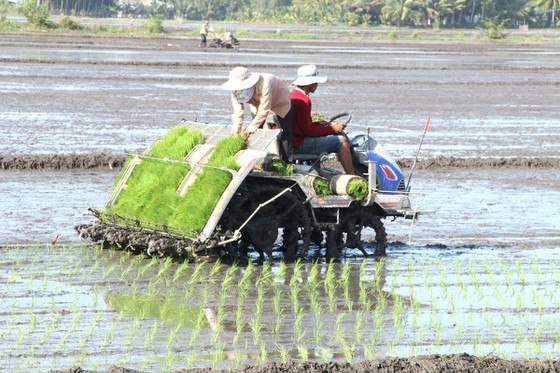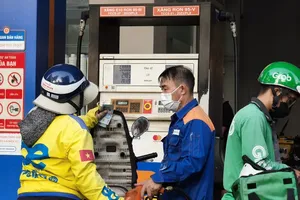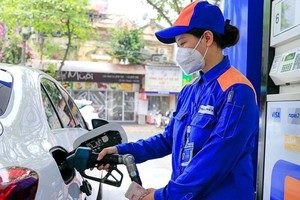
In the chilly weather at the end of the rainy season, in the paddy fields in Hung Thanh Commune in Tan Hung District of Long An Province, there is no longer the image of farmers wading in the fields to plant rice. Instead, they gather on the edge of the rice field, chatting with each other while watching rice planting by machines. Not only planting rice, but farmers also mechanize the plowing and the spraying of pesticides by unmanned equipment and the harvesting by the combine harvesters.
Mr. Tran Van Do, a farmer in Cai Be District in Tien Giang Province, recalled that in the ‘90s of the previous century, farmers harvested rice by the manual method of the sickle. It took a day to harvest 1,000 square meters of paddy. Then when the technology was a little advanced, sickles were replaced by harvesters. However, there were many accidents caused by these machines. It was difficult to separate paddy from straws and dust. Fortunately, with technology development, the combine harvesters were invented. Farmers only have to rent a combine harvester at VND150,000 per 1,000 square meters. Owing to that they can reduce labor power and expenses, increase efficiency and lower losses during harvesting. They only need to move the machine to the paddy field that needs harvesting then let the machine do its job, after that it just needs a person to help with packing paddy right at the field.
Meanwhile, Mr. Do Dinh Dan, a farmer in Long An Province, uses an unmanned spray system. It takes only 15 to 20 minutes for the unmanned spray system to spray a hectare of rice equally, whereas it takes four hours if using manual sprayers. This is the second crop he has used a rice disease monitoring system. He said that using the manual sprayer, his rice field is not sprayed equally. A hectare of rice needs on average 10-12 manual sprayers with a rental price of VND12,000-VND15,000 per manual sprayer. Meanwhile, an unmanned sprayer rents at around VND160,000 per hectare and the amount of plant protection drug is cut by 20 percent. Besides, spraying by unmanned spray system gives higher productivity as farmers do not have to step on rice and farmers do not have to worry about their health as they are not exposed to plant protection drugs.
The State’s policy is to direct farmers to produce following the requirements of the market and change the traditional cultivation thinking to the modern one. However, many large-scale paddy fields usually encounter the situation that the prices of services are extremely high when it is time to spray plant protection drugs or to harvest. Therefore, Mr. Tran Van Sua, a farmer in Moc Hoa District in Long An Province, said that cooperative groups and cooperatives need to cooperate with enterprises for the supply of seeds and fertilizers, mechanization and technology application. The cooperatives buy equipment to serve their production then rent that equipment when they do not need to use it.
Mr. Tran Van Do, a farmer in Cai Be District in Tien Giang Province, recalled that in the ‘90s of the previous century, farmers harvested rice by the manual method of the sickle. It took a day to harvest 1,000 square meters of paddy. Then when the technology was a little advanced, sickles were replaced by harvesters. However, there were many accidents caused by these machines. It was difficult to separate paddy from straws and dust. Fortunately, with technology development, the combine harvesters were invented. Farmers only have to rent a combine harvester at VND150,000 per 1,000 square meters. Owing to that they can reduce labor power and expenses, increase efficiency and lower losses during harvesting. They only need to move the machine to the paddy field that needs harvesting then let the machine do its job, after that it just needs a person to help with packing paddy right at the field.
Meanwhile, Mr. Do Dinh Dan, a farmer in Long An Province, uses an unmanned spray system. It takes only 15 to 20 minutes for the unmanned spray system to spray a hectare of rice equally, whereas it takes four hours if using manual sprayers. This is the second crop he has used a rice disease monitoring system. He said that using the manual sprayer, his rice field is not sprayed equally. A hectare of rice needs on average 10-12 manual sprayers with a rental price of VND12,000-VND15,000 per manual sprayer. Meanwhile, an unmanned sprayer rents at around VND160,000 per hectare and the amount of plant protection drug is cut by 20 percent. Besides, spraying by unmanned spray system gives higher productivity as farmers do not have to step on rice and farmers do not have to worry about their health as they are not exposed to plant protection drugs.
The State’s policy is to direct farmers to produce following the requirements of the market and change the traditional cultivation thinking to the modern one. However, many large-scale paddy fields usually encounter the situation that the prices of services are extremely high when it is time to spray plant protection drugs or to harvest. Therefore, Mr. Tran Van Sua, a farmer in Moc Hoa District in Long An Province, said that cooperative groups and cooperatives need to cooperate with enterprises for the supply of seeds and fertilizers, mechanization and technology application. The cooperatives buy equipment to serve their production then rent that equipment when they do not need to use it.
 Farmers plant rice by rice transplanter. (Photo: SGGP)
Farmers plant rice by rice transplanter. (Photo: SGGP)
By this winter-spring rice crop, Loc Troi Corporation has associated with 7,316 farming households in provinces in the Mekong Delta with a total area of more than 21,948 hectares, of which, the largest paddy field is around 10,000 hectares in An Giang Province. Since 2010, the company has applied advanced technological solutions to build a sustainable rice value chain, applying the international standards of sustainable rice platform which includes 41 criteria on good rice field management practices, good water management practices, pest management, nutrient management, post-harvest loss reduction, food safety, and health safety. With five processing plants, the group has been shifting from linking with each household to linking with cooperative groups and cooperatives to concentrate the resources to mechanize, apply new technology and safe rice production process to help to increase the value of Vietnamese rice. The households cooperating with the group are provided seeds, fertilizers, plant protection drugs and the process of using agricultural materials. Mr. Nguyen Nhu Cuong, Director of the Department of Plant Production under the Ministry of Agriculture and Rural Development, said that in the future, rice production must be mechanized and automatized to increase efficiency and competitiveness to make up for a shortage of labor in the rural area. Agriculture encourages the establishment of cooperative groups and cooperatives specializing in the engineering field, such as unmanned equipment and mechanization in harvesting to improve effectiveness and competitiveness. According to Mr. Tran Thanh Nam, Deputy Minister of the MARD, farmers, and cooperatives do not have markets for consumption so it is right to associate with enterprises. Enterprises have markets so they can direct the output and bring mechanization, technology, and even agricultural engineers, seeds, fertilizers, and agricultural materials to the fields to help the products to meet the quality that the market requires.
























